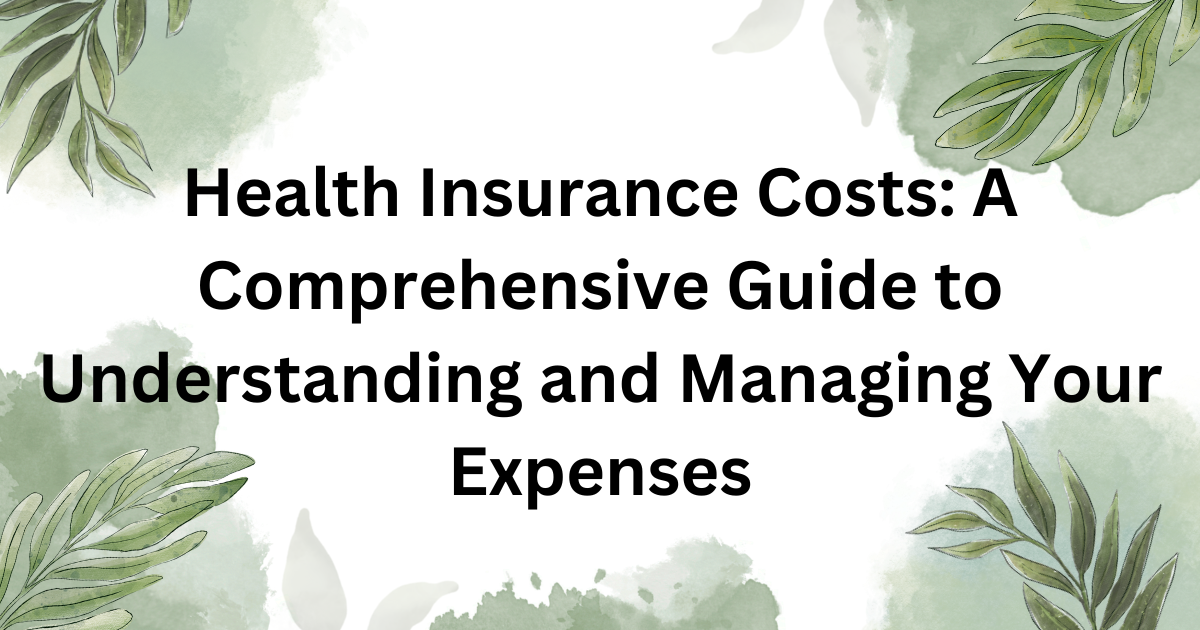Health insurance is a critical part of financial planning and access to healthcare, but it often comes with significant costs that can be challenging to manage. As healthcare expenses rise, so do the premiums, deductibles, and out-of-pocket costs that come with health insurance. Whether you are purchasing insurance through your employer, the marketplace, or a private insurer, understanding how health insurance costs are structured and what you can do to manage them is essential for making informed decisions.
This article will break down the various components that contribute to health insurance costs, discuss factors that influence pricing, and provide strategies for reducing your healthcare expenses while ensuring that you are adequately covered.
The Breakdown of Health Insurance Costs
Health insurance costs can be divided into several key components, each of which impacts the total amount you pay for healthcare throughout the year. Understanding these components will help you choose a plan that best suits your budget and healthcare needs.
1. Premiums
The premium is the amount you pay, typically on a monthly basis, to maintain your health insurance coverage. It is a fixed cost, meaning you must pay it whether or not you use any medical services. Premiums vary widely depending on the type of plan you select, your location, and other factors, which will be discussed later in this article.
2. Deductibles
The deductible is the amount you must pay out-of-pocket for healthcare services before your insurance starts covering costs. For example, if your plan has a $1,500 deductible, you will need to pay $1,500 for medical services before the insurance company starts paying for covered care. Deductibles vary by plan and can range from a few hundred dollars to several thousand dollars annually. Plans with higher deductibles typically have lower premiums, while plans with lower deductibles come with higher monthly premiums.
3. Copayments and Coinsurance
Once you meet your deductible, you may still need to pay part of the costs for medical services in the form of copayments (copays) or coinsurance.
- Copayments are fixed amounts you pay for specific services, such as $20 for a doctor’s visit or $50 for an emergency room visit. The amount of the copay depends on the service and the terms of your insurance plan.
- Coinsurance is a percentage of the cost of a service that you are required to pay after meeting your deductible. For example, if your coinsurance is 20%, you would pay 20% of the cost of a covered service, and your insurance company would cover the remaining 80%.
4. Out-of-Pocket Maximum
The out-of-pocket maximum is the most you will pay in a year for covered healthcare services, including deductibles, copays, and coinsurance. Once you reach this limit, your insurance will pay 100% of covered medical expenses for the rest of the year. This is an important feature because it limits your financial risk, especially in the case of serious illness or injury.
Factors That Affect Health Insurance Costs

Several factors influence the cost of health insurance. While some are within your control, others are determined by broader market and individual factors. Here’s what you need to consider:
1. Plan Type
Health insurance plans come in different types, and each type has its own cost structure. The main types include:
- Health Maintenance Organization (HMO): These plans typically have lower premiums and out-of-pocket costs, but they require you to use in-network providers. You also need a referral from your primary care physician (PCP) to see specialists.
- Preferred Provider Organization (PPO): PPOs offer more flexibility in choosing healthcare providers, including out-of-network care. However, this flexibility comes at a cost—PPOs generally have higher premiums and out-of-pocket expenses than HMOs.
- Exclusive Provider Organization (EPO): EPOs require you to use in-network providers but do not require referrals for specialists. They offer a middle ground between HMOs and PPOs in terms of flexibility and cost.
- Point of Service (POS): These plans combine features of HMOs and PPOs. You need a referral to see a specialist, but you can also use out-of-network providers, though at a higher cost.
2. Age
Age is one of the most significant factors in determining health insurance premiums. Older individuals typically pay higher premiums because they are more likely to need healthcare services. Under the Affordable Care Act (ACA), insurance companies cannot charge older individuals more than three times what they charge younger individuals, but the cost difference can still be substantial.
3. Location
Where you live has a big impact on your health insurance costs. Healthcare costs and provider availability vary by state and region, and these differences are reflected in insurance premiums. States with a more competitive insurance market or lower healthcare costs tend to have lower premiums.
4. Tobacco Use
Under the ACA, insurance companies can charge smokers up to 50% more than non-smokers. If you are a smoker, quitting can not only improve your health but also significantly lower your health insurance costs.
5. Coverage Level
Health insurance plans are typically categorized into four metal tiers: Bronze, Silver, Gold, and Platinum. These categories reflect the percentage of healthcare costs the plan covers, with Bronze covering the least and Platinum covering the most. Here’s a quick breakdown:
- Bronze Plans: Low premiums, but high deductibles and out-of-pocket costs. These plans are suitable for individuals who are relatively healthy and do not expect to use many healthcare services.
- Silver Plans: Moderate premiums and moderate out-of-pocket costs. These plans are often chosen by people who expect to need healthcare services occasionally.
- Gold Plans: Higher premiums but lower deductibles and out-of-pocket costs. Ideal for individuals who expect to use healthcare services frequently.
- Platinum Plans: The highest premiums and the lowest out-of-pocket costs. These plans are best for individuals with chronic conditions or those who expect to have significant medical expenses.
6. Employer Contributions
If you receive health insurance through your employer, your costs may be significantly lower because most employers contribute to the premium costs. The amount of this contribution can vary, but on average, employers cover about 70% of the premium for family coverage. The remaining portion is your responsibility.
Strategies to Reduce Health Insurance Costs
Healthcare expenses can be a significant financial burden, but there are several strategies you can use to reduce your health insurance costs while still ensuring you have adequate coverage.
1. Shop Around During Open Enrollment
Health insurance plans and costs can change from year to year, so it’s important to review your options during the annual open enrollment period. Whether you get insurance through your employer or the marketplace, comparing different plans can help you find one that better meets your needs and budget.
2. Choose a High-Deductible Health Plan (HDHP)
High-deductible health plans come with lower premiums but higher out-of-pocket costs. These plans can be a good option if you are generally healthy and do not expect to need extensive medical care. However, it’s important to have savings set aside to cover the higher deductible in case of unexpected healthcare expenses.
3. Use a Health Savings Account (HSA)
If you have a high-deductible health plan, you may be eligible to contribute to a Health Savings Account (HSA). HSAs offer tax advantages because contributions are tax-deductible, the money grows tax-free, and withdrawals for qualified medical expenses are also tax-free. HSAs allow you to save money specifically for healthcare expenses, and the funds roll over year to year, unlike Flexible Spending Accounts (FSAs), which are use-it-or-lose-it.
4. Take Advantage of Preventive Care
Many health insurance plans cover preventive care services at no cost to you. This includes annual checkups, screenings, vaccinations, and other services designed to catch health issues early. By taking advantage of these services, you can potentially avoid more serious and costly health problems down the road.
5. Use In-Network Providers
To minimize your healthcare expenses, always try to use in-network providers. Health insurance companies negotiate lower rates with these providers, which can significantly reduce the amount you pay for care. If you see an out-of-network provider, you may be responsible for a much larger portion of the cost.
6. Look for Subsidies and Financial Assistance
If you purchase health insurance through the marketplace, you may be eligible for subsidies or premium tax credits based on your income. These financial assistance programs can help reduce your monthly premiums and out-of-pocket costs. Be sure to explore whether you qualify for subsidies when selecting a plan.
7. Participate in Employer Wellness Programs
Many employers offer wellness programs that incentivize healthy behaviors. By participating in these programs, you may be able to lower your premiums, earn cash rewards, or receive other perks. These programs often include activities like attending health screenings, exercising regularly, or quitting smoking.
8. Negotiate Medical Bills
If you receive a large medical bill, don’t be afraid to negotiate with your healthcare provider. Many providers are willing to offer discounts or payment plans, especially if you are uninsured or experiencing financial hardship. You can also hire a medical billing advocate to help negotiate on your behalf.
The True Cost of Going Without Health Insurance
While health insurance can be expensive, going without coverage is far riskier. Without health insurance, you are responsible for paying the full cost of any medical services you receive. Even routine care like doctor’s visits and prescription drugs can add up quickly, and major
medical events like surgeries or hospitalizations can lead to catastrophic financial consequences.
In addition to the immediate costs of medical care, going without health insurance can also have long-term effects on your health. Without coverage, people are less likely to seek preventive care, delaying diagnosis and treatment for serious conditions. This can result in worse health outcomes and higher healthcare costs in the future.
Conclusion
Health insurance is a vital tool for protecting yourself against high medical costs, but it also comes with its own set of expenses. By understanding the components that make up health insurance costs and learning how to manage them, you can make more informed decisions about your healthcare coverage.
